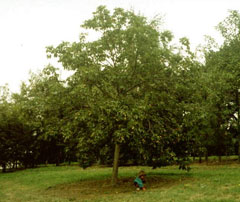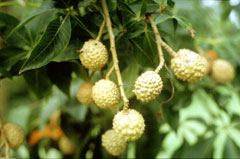 |
|
(c) ken Fern, Plants For A Future 2010 |
 |
| (c) ken Fern, Plants For A Future 2010 |
Translate this page:
Summary
Bloom Color: Yellow.
Main Bloom Time: Early spring, Late spring, Mid spring. Form: Rounded.
Physical Characteristics

 Aesculus glabra is a deciduous Tree growing to 20 m (65ft 7in) at a medium rate.
Aesculus glabra is a deciduous Tree growing to 20 m (65ft 7in) at a medium rate.
See above for USDA hardiness. It is hardy to UK zone 5 and is not frost tender. It is in flower from June to July, and the seeds ripen in October. The species is hermaphrodite (has both male and female organs).
Suitable for: light (sandy), medium (loamy) and heavy (clay) soils. Suitable pH: mildly acid, neutral and basic (mildly alkaline) soils. It can grow in semi-shade (light woodland) or no shade. It prefers moist soil.
UK Hardiness Map
US Hardiness Map
Synonyms
Plant Habitats
Woodland Garden Canopy;
Edible Uses
Edible Parts: Seed
Edible Uses:
Seed - cooked[222]. It can be dried, ground into a flour and used as a gruel. The seed is quite large, up to 35mm in diameter[82], and is easily harvested[K]. It is quite rich in saponins and needs to be leached of these toxins before it becomes safe to eat - the Indians would do this by slow-roasting the nuts (which would have rendered the saponins harmless) and then cutting them into thin slices, putting them into a cloth bag and rinsing them in a stream for 2 - 5 days. By this time most of the minerals etc would also have been leached out[K].
References More on Edible Uses
Medicinal Uses
Plants For A Future can not take any responsibility for any adverse effects from the use of plants. Always seek advice from a professional before using a plant medicinally.
Antispasmodic Miscellany
Minute doses of the seed are used internally in the treatment of spasmodic coughs, asthma and internal irritations[222]. It is used externally as a tea or an ointment in the treatment of rheumatism and piles[222]. An extract of the bark has been used as an irritant of the cerebro-spinal system[82].
References More on Medicinal Uses
The Bookshop: Edible Plant Books
Our Latest books on Perennial Plants For Food Forests and Permaculture Gardens in paperback or digital formats.

Edible Tropical Plants
Food Forest Plants for Hotter Conditions: 250+ Plants For Tropical Food Forests & Permaculture Gardens.
More

Edible Temperate Plants
Plants for Your Food Forest: 500 Plants for Temperate Food Forests & Permaculture Gardens.
More

More Books
PFAF have eight books available in paperback and digital formats. Browse the shop for more information.
Shop Now
Other Uses
Miscellany Soap Wood
Saponins in the seed are used as a soap substitute[169]. The saponins can be easily obtained by chopping the seed into small pieces and infusing them in hot water. This water can then be used for washing the body, clothes etc. Its main drawback is a lingering odour of horse chestnuts[K]. Wood - close-grained, light, soft, white, but often blemished by dark lines of decay[82, 229]. It weighs 28lb per cubic foot[235]. It is easy to carve and resists splitting. Ideal to use in making artificial limbs, it is also used for woodenware, pulp etc and is occasionally sawn into lumber[82, 229, 235].
Special Uses
References More on Other Uses
Cultivation details
Landscape Uses:Specimen, Street tree. Prefers a deep loamy well-drained soil but is not too fussy[1, 11]. This species is the state tree of Ohio[229]. Its growth-rate is moderate in the wild, with trees living up to 100 years[229]. In Britain, it grows best in eastern and south-eastern areas of England probably needing a continental climate in order to thrive[126, 200]. Although the trees are hardy when dormant, the new growth can be damaged by late spring frosts[11]. The twigs, bark, flowers and leaves all produce a foetid odour if crushed[229]. Most members of this genus transplant easily, even when fairly large[11]. Special Features:Attractive foliage, North American native, Fragrant foliage, All or parts of this plant are poisonous, Blooms are very showy.
References Carbon Farming Information and Carbon Sequestration Information
Temperature Converter
Type a value in the Celsius field to convert the value to Fahrenheit:
Fahrenheit:
The PFAF Bookshop
Plants For A Future have a number of books available in paperback and digital form. Book titles include Edible Plants, Edible Perennials, Edible Trees,Edible Shrubs, Woodland Gardening, and Temperate Food Forest Plants. Our new book is Food Forest Plants For Hotter Conditions (Tropical and Sub-Tropical).
Shop Now
Plant Propagation
Seed - best sown outdoors or in a cold frame as soon as it is ripe[11, 80]. The seed germinates almost immediately and must be given protection from severe weather[130]. The seed has a very limited viability and must not be allowed to dry out. Stored seed should be soaked for 24 hours prior to sowing and even after this may still not be viable[80, 113]. It is best to sow the seed with its 'scar' downwards[130]. If sowing the seed in a cold frame, pot up the seedlings in early spring and plant them out into their permanent positions in the summer.
Other Names
If available other names are mentioned here
Native Range
NORTHERN AMERICA: United States (Indiana, Michigan (south), Ohio, Pennsylvania (west), West Virginia (west), Illinois, Iowa, Kansas (east), Missouri, Nebraska (southeast), Oklahoma, Alabama (north), Arkansas, Kentucky, Mississippi (east), Tennessee, Texas)
Weed Potential
Right plant wrong place. We are currently updating this section.
Please note that a plant may be invasive in one area but may not in your area so it's worth checking.
Conservation Status
IUCN Red List of Threatened Plants Status :

Growth: S = slow M = medium F = fast. Soil: L = light (sandy) M = medium H = heavy (clay). pH: A = acid N = neutral B = basic (alkaline). Shade: F = full shade S = semi-shade N = no shade. Moisture: D = dry M = Moist We = wet Wa = water.
Now available:
Food Forest Plants for Mediterranean Conditions
350+ Perennial Plants For Mediterranean and Drier Food Forests and Permaculture Gardens.
[Paperback and eBook]
This is the third in Plants For A Future's series of plant guides for food forests tailored to
specific climate zones. Following volumes on temperate and tropical ecosystems, this book focuses
on species suited to Mediterranean conditions—regions with hot, dry summers and cool, wet winters,
often facing the added challenge of climate change.
Read More
Expert comment
Author
Willd.
Botanical References
11200
Links / References
For a list of references used on this page please go here
Readers comment
| Add a comment |
|
If you have important information about this plant that may help other users please add a comment or link below. Only comments or links that are felt to be directly relevant to a plant will be included. If you think a comment/link or information contained on this page is inaccurate or misleading we would welcome your feedback at [email protected]. If you have questions about a plant please use the Forum on this website as we do not have the resources to answer questions ourselves.
* Please note: the comments by website users are not necessarily those held by PFAF and may give misleading or inaccurate information.
To leave a comment please Register or login here All comments need to be approved so will not appear immediately.
|
Subject : Aesculus glabra
|
|
|
|